

Jon Clements, Author (unless otherwise noted) and Editor
Current degree day accumulations
New England Tree Fruit Management Guide on-line
| UMass Cold Spring Orchard, Belchertown, MA |
1-May |
| Base 43 (BE, NEWA) | 443 |
| Base 50 (BE, NEWA) | 225 |
Note that apple petal fall should occur app. 254 DD (Base 50 BE), although obviously there is a range. We are currently at 225 DD's Base 50 BE in Belchertown. Based on the degree-day forecast, we will be at petal fall in Belchertown on app. Monday, May 8.
Current bud stages. May 1, 2017, UMass Cold Spring Orchard, Belchertown, MA
 |
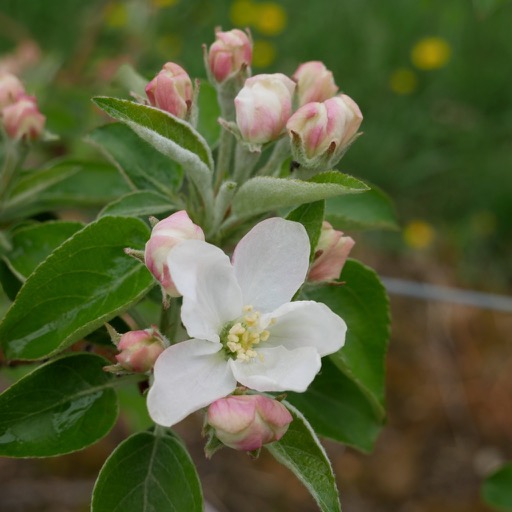 |
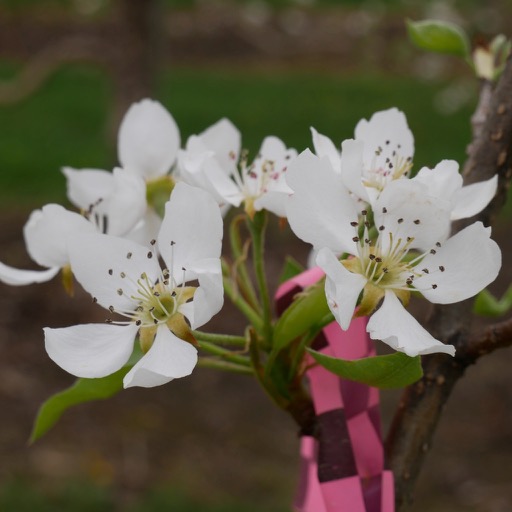 |
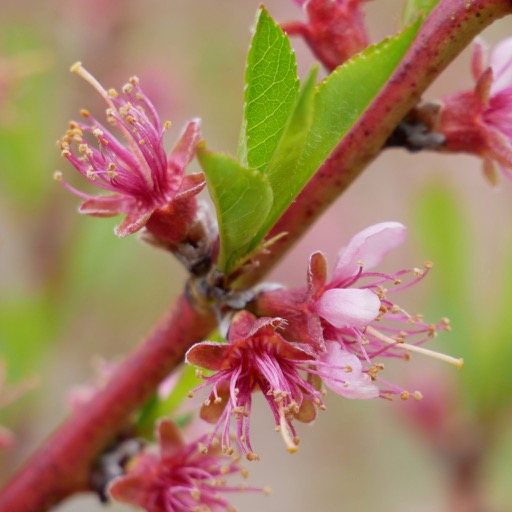 |
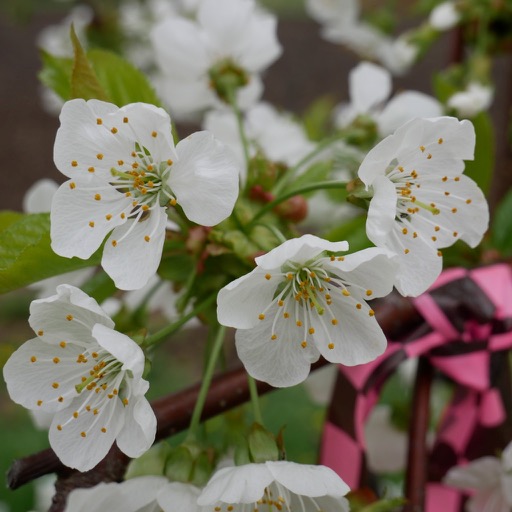 |
McIntosh apple 80% full bloom |
Honeycrisp apple early king bloom |
Gold bosc pear bloom |
Redhaven peach begin petal fall |
Regina sweet cherry bloom |
Note: for archive of bud stages, see Bud Stages Photos
| Coming events | Degree days (Base 43 BE) |
| Codling moth 1st catch | 396-566 |
| European red mite egg hatch complete | 368-470 |
| Green fruitworm flight subsides | 267-465 |
| Lesser appleworm 1st catch | 276-564 |
| Lesser appleworm 1st flight peak | 364-775 |
| Mullein plant bugs 1st hatch | 331-443 |
| Oriental fruit moth 1st flight peak | 329-534 |
| Spotted tentiform leafminer 1st flight peak | 268-407 |
| Spotted tentiform leafminer sapfeeding mines present | 343-601 |
| White apple leafhopper nymphs on apple | 302-560 |
Key insect life cycle and management dates
Note: for 2017, we have four Massachusetts orchard locations subscribed to AR: Amherst, Belchertown, Deerfield, and Easthampton. The website for looking at AgRadar for these locations is: http://extension.umaine.edu/ipm/ag-radar-apple-sites/. What follows is the AgRadar summary for the Belchertown location.
Estimated apple Scab Ascopsore Maturity, 1-May -- 55%
Codling moth CM -- too early for CM status report
Lesser Appleworm LAW -- 1st LAW flight begins around: May 6, Saturday. Peak trap catch: May 19.
Oriental Fruit Moth OFM -- 1st generation OFM flight starts: April 26, Wednesday. 1st generation 55% egg hatch and first treatment date, if needed: May 27, Saturday.
Plum curculio (PC) -- Increased risk of PC damage as McIntosh and similar cultivars increase in fruit size: May 18, Thursday.
San Jose scale (SJS) -- First adult SJS caught on trap: May 16, Tuesday.
Spotted Tentiform Leafminer STLM -- 1st STLM flight, peak trap catch: May 4, Thursday. 1st generation sapfeeding mines start showing: May 17, Wednesday. Optimum sample date is around Thursday, May 18, when a larger portion of the mines are visible.
White apple leafhopper (WAL) -- 1st generation WAL found on apple foliage: May 7, Sunday.
McIntosh Bud Stages -- Tuesday, May 2: Full Bloom; Wednesday, May 10: 95% Petal Fall; Saturday, May 13: 100% Petal Fall
3-May, 2017 (Wednesday) Airblast Sprayer Calibration Demonstration at 3 PM. Outlook Farm 136 Main Road, Westhampton, MA. http://www.outlookfarm.com/ Co-sponsored by UMass Extension Integrated Crop Management Program (eIP). 1 pesticide credit will be offered. $20 admission. Contact: Jon Clements, 413-478-7219. Pre-registration is not necessary.
10-May, 2017 (Wednesday) Fruit Twilight/Thinning meeting, 5:30 PM. Honey Pot Hill Orchards, 138 Sudbury Road, Stow, MA. http://www.honeypothill.com/ 1 pesticide credit will be offered. $20 admission. Light supper will be served. Contact: Jon Clements, 413-478-7219. Pre-registration is not necessary.
11-May, 2017 (Thursday) Fruit Twilight/Thinning meeting, 5:30 PM. UMass Cold Spring Orchard, 391 Sabin Street, Belchertown, MA. http://coldspringorchard.com/ 1 pesticide credit will be offered. $20 admission. Light supper will be served. Contact: Jon Clements, 413-478-7219. Pre-registration is not necessary.
For more information and updates, see Upcoming Events
Jon Clements
• OK, we are in bloom, and new news (NOT!), the weather is not cooperating. It's a bit of a bummer, because it is generally a HUGE bloom (with a few exceptions). Not to be the glass-half-empty kind of guy I am, so we can all assume we will have enough good weather which now appears like it might be an extended bloom to set a crop of apples. (Mother Nature always wins, right?) Our fruit twilight/thinning meetings next week (see Upcoming meetings) should be interesting, hope to see you there along with Duane Greene (who we, as usual, will put on the spot).
• We're in the midst of a massive apple scab infection period across the board. Cover up and kick-back with appropriate fungicides for scab (and mildew and rust and rots, see Disease activity/efficacy of apple fungicides) nearly every time there is a break in the weather. Like this Thursday, if not today. Fire blight is a non-issue. See more below in Diseases.
• Many people seem to think insect activity is pretty low, which given the relatively cool temperatures makes sense. But the pedal typicall gets pushed to the metal with bloom and petal fall. We have found Oriental fruit moth, European apple sawfly, pear psyall and gypsy moth at the UMass Orchard in the past week. See a bit more below in Insects.
• Shoot growth control applications of Apogee/Kudos need to go on no later than petal fall, so work that into your spray program. See Duane Greene's comments below and on petal fall chemical thinner applications.
• The New England Extension tree fruit specialists -- which include myself and Dan Cooley at UMass. Mary Concklin at UConn, Heather Faurbert at URI, Terry Bradshaw at UVM, George Hamilton and Alan Eaton at UNH, and Glen Koehler and Renae Moran at UMaine -- have started to contribute to an on-line edition of the New England Tree Fruit Management Guide. Call it a beta version if you will, but we think it has some value in 2017 as we continue to work on it. (Consider it dynamic? Work-in-progress? Under construction?) But many of the spray tables (for lack of a better description) are filled out. Note that is it easy to print any of the sections, if you want to have old-school reference, for examplle, to hang on your spray shed wall. Also, it is quite mobile-friendly so make a home screen shortcut to here: http://netreefruit.org.
Jon Clements and Elizabeth Garofalo
List of recently WANTED, FOUND, and ERADICATED?
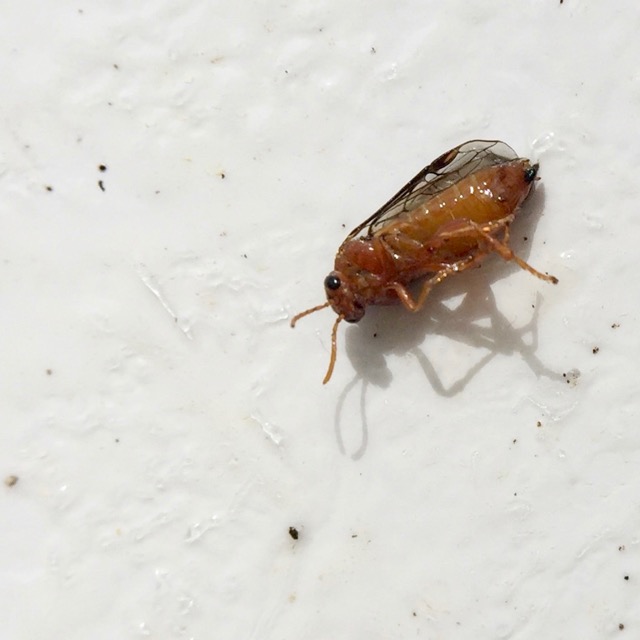 |
European apple sawfly (EAS) -- what, me? Typically makes an appearance just before bloom and begins laying eggs before petal fall is over! If you are worried about EAS, you need to get an insecticide (carbaryl, Imidan, Actara, Assail, Avaunt, Altacor, Exirel) as soon as bloom as over and bees are out of the orchard. |
| Pear psylla Adults are laying eggs. Surround is a good option to deter egglaying, but doubt it is used by many. Suggested conventional insecticide approaches would include Portal, Exirel, Centaur, or Sivanto. Be sure bees are done before applying insecticides. |
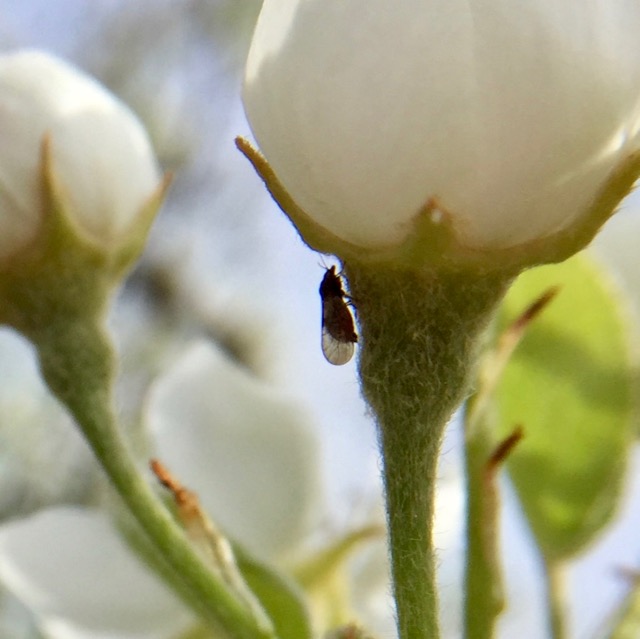 |
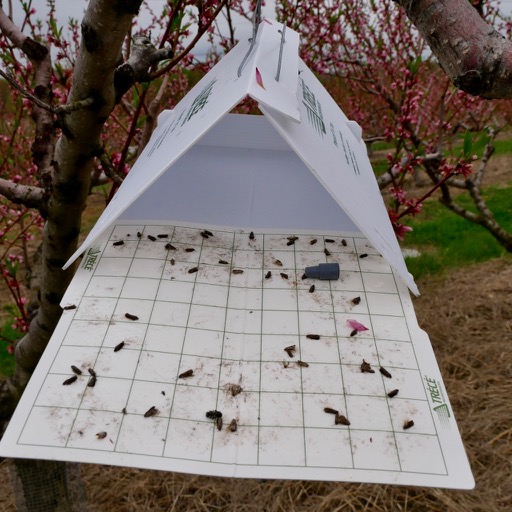 |
Oriental fruit moth (OFM) Pheromone trap catches are high on warmer days. Petal fall insecticide sprays usually take care of OFM, however, we're inclined to think there is some late season fruit damage from OFM that may be attributed to other things. Pheromone traps are highly recommended to monitor OFM. |
| Gypsy moth -- we're BACK (and a little fuzzy out of focus)! Watch for gypsy moth infestation and potential defoliation of young apple plantings in particular. Almost any insecticide will take care of that, but Imidan is quick and effective. |
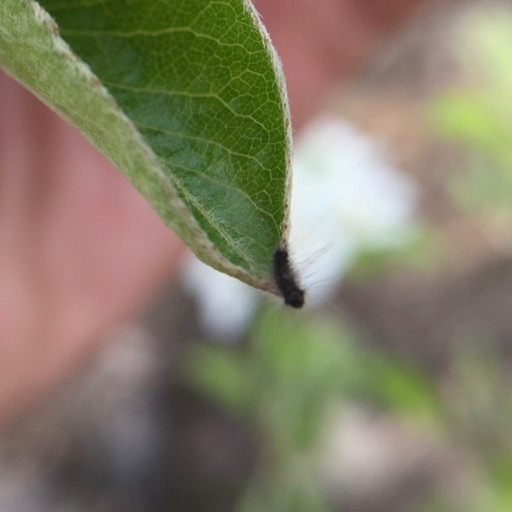 |
Dan Cooley
Scab. If you’re not spraying for scab whenever the weather gives you a chance this week, you might want to consider getting out of the apple business. We can confirm that you should be playing it safe, using the highest rates of the most effective fungicides you have during the present and predicted wet weather over the next week. Here is a picture Liz Garofalo took of a cloud of spores ejected in a 10-minute lab test Monday. It is a heavy release. Therfore, scab infection risk is peaking.
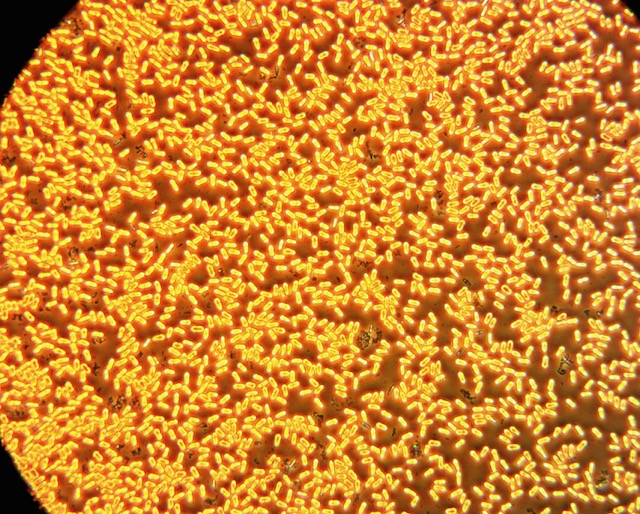
With this much rain and the peak of ascospore release, the nuances and fine points of scab epidemics are not so important. For example, if leaves are wet for a couple of days, it doesn’t matter that ascospores are less likely to be released at night. Note the words “less likely”. At times when there is a lot of inoculum, like now, spores can be released during the dark hours. The few hours difference between night release and dawn release generally don’t matter. But if we are in a grey area, say a rain that starts at night and rapid leaf drying the next day, they might.
Mildew, Rust and Rots. If you have had problems with mildew and/or rust, make sure that your scab fungicides also control these diseases, or that you are adding something that does. Black rot and bitter rot can be active now, but the most critical period for protecting against those diseases comes after fruit set. Efficacy of apple fungicides is in the on-line New England Tree Fruit Management Guide under Apples > Spray Table.
Mancozeb products (Dithane, Penncozeb, Manzate et al.) or Polyram cover the scab/rust/rot spectrum well, but in this time of high scab pressure, should be teamed with a systemic material with good kickback that also has some mildew efficacy.
At this time, particularly if using Regulaid or other spray materials that enhance pesticide uptake, reduce the risk of fruit russet by avoiding captan until a week or two after fruit set.
Fire Blight. As I said in the message we sent out Sunday, whether you were at a high risk of fire blight infection this past week depended largely on when bloom started in your orchard. The later the start, the less risk, and if bloom didn’t start by the end of warm weather then there was no chance of bloom infection. In orchards that started bloom by Thursday or earlier, there was significant chance of infection with wetting Saturday, though temperatures cooled rapidly. With that, the risk of new infections has pretty much disappeared for the foreseeable future.
Duane Greene
Apogee and Kudos
Maximum growth control can be achieved by making the initial application of Apogee starting at or near the Pink stage when there is sufficient leaf area to absorb the spray. Because the leaf area is limited at this time, we have been recommending the use of the 9 oz/100 gal rate. Comments from some who have tried the earlier application of Apogee suggest that the amount of growth control achieved with this treatment may be too great. Alternatively, we suggest delaying the initial application closer to petal fall and use 4 to 6 oz/100 gal. By altering the time of application, and to a lesser extent the rate used, it should possible to achieve the extent of growth control desired in a specific block of trees.
Early Chemical thinning
Many orchards are in bloom or will soon be in bloom. Full bloom offers the first opportunity to chemically thin, although few take advantage of this time to start the thinning program. The biggest concern is uncertainty about weather during the pollination period. Starting early provides the best opportunity to achieve good fruit size at harvest and assure adequate return bloom. Amid-Thin at 8 oz/100 gal or NAA at 12 to 15 ppm are two hormone options you have at this stage of development. The use of caustic thinners such as ATS or lime sulfur and oil may cause some phytotoxicity which may result in no fruit size benefit at harvest even if thinning does occur.
Petal fall is a perennial favorite time to thin used by many growers. Frequently carbaryl is used. It is safe to use and it rarely overthins. Many growers have a snowball bloom this year after last year with a reduced crop. Under these circumstances carbaryl is only a band-aid. It will most likely not get the job done, when used alone. I encourage all who have a heavy strong return bloom to combine carbaryl with NAA or Amid-Thin. Fruit are not nearly as sensitive to NAA at either bloom or petal fall so the use of higher rates is not only advisable but probably necessary. For the bloom spray I usually suggest that you apply a thinner even if the weather is not perfect, as long as you get good coverage. Petal fall is a nebulous term describing a period of time after bees are removed from the orchard. It is generally a good idea to get your petal fall thinning spray on as soon as possible. The weather for this week is not forecast to be favorable, however, do not wait too long. The earlier you get started the better. The only exception to this is if you do not want to follow up with another thinner application.
During petal fall and for a few days after fruit do not grow very much. You do not see much growth increase until the fruit reach 5-6 mm in size. Therefore, I do not put a great deal of emphasis on the carbon balance model until fruit reach this 5-6 mm size. If fruit are not growing then the demand for carbohydrate is not large. Growers who wish to thin without carbaryl must be more aggressive with the other thinners at this time.
The bloom-petal fall period is extremely important in the overall thinning scheme. If you are going to be aggressive in thing this is the time to do it.
No Guest article this week...BUT, if you really want to know more about fire blight this year, read this comprehensive discussion in Scaffolds Fruit Journal.
Follow me (jmcextman) on FB: https://www.facebook.com/jmcextman
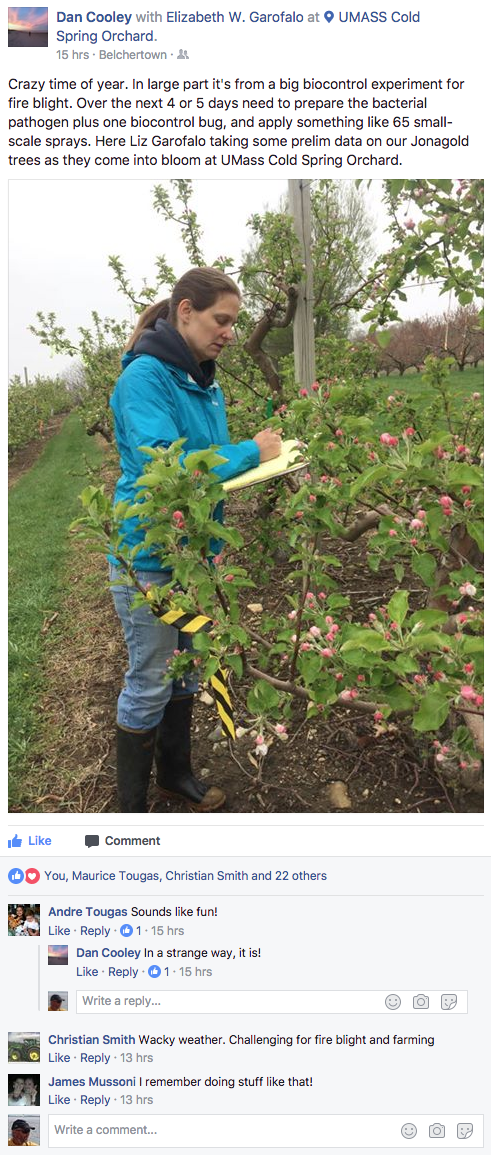
New England Tree Fruit Management Guide
UMass Fruit Advisor: http://umassfruit.com
Scaffolds Fruit Journal: http://www.nysaes.cornell.edu/ent/scafolds/
Network for Environment and Weather Applications (NEWA): http://newa.cornell.edu
Follow me on Twitter (http://twitter.com/jmcextman) and Facebook (http://www.facebook.com/jmcextman)
The next Healthy Fruit will be published on Tuesday, May 9 or thereabouts, 2017. As always feel free to get in touch with any member of the UMass Fruit Team (http://extension.umass.edu/fruitadvisor/team-members) if you have questions or comments.